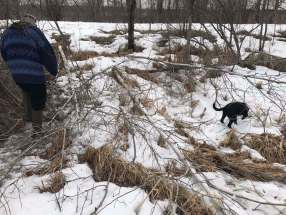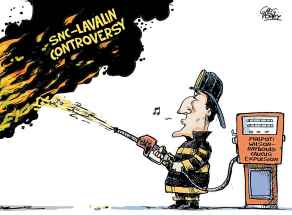Our game, our family, our grief Humboldt's scars will never fully heal but the lessons and legacies may ease the pain
Read this article for free:
or
Already have an account? Log in here »
To continue reading, please subscribe:
Monthly Digital Subscription
$0 for the first 4 weeks*
- Enjoy unlimited reading on winnipegfreepress.com
- Read the E-Edition, our digital replica newspaper
- Access News Break, our award-winning app
- Play interactive puzzles
*No charge for 4 weeks then price increases to the regular rate of $19.00 plus GST every four weeks. Offer available to new and qualified returning subscribers only. Cancel any time.
Monthly Digital Subscription
$4.75/week*
- Enjoy unlimited reading on winnipegfreepress.com
- Read the E-Edition, our digital replica newspaper
- Access News Break, our award-winning app
- Play interactive puzzles
*Billed as $19 plus GST every four weeks. Cancel any time.
To continue reading, please subscribe:
Add Free Press access to your Brandon Sun subscription for only an additional
$1 for the first 4 weeks*
*Your next subscription payment will increase by $1.00 and you will be charged $16.99 plus GST for four weeks. After four weeks, your payment will increase to $23.99 plus GST every four weeks.
Read unlimited articles for free today:
or
Already have an account? Log in here »
Hey there, time traveller!
This article was published 05/04/2019 (2439 days ago), so information in it may no longer be current.
It’s been a year, and time is strange. It twists memories in unexpected ways, stretching them into place, distorting them until its passage is concealed and objects in the rear-view mirror are closer than they appear, until everything that haunts us feels like it just happened yesterday, even though it’s already been a year.
So maybe you still remember where you were when you heard the news. At home, out for dinner, early the next morning over breakfast. Reading the headlines, trying to make sense of what they were saying, stomach sinking under the weight of growing numbers.
Junior hockey team bus crash. Rural Saskatchewan. Many dead. Many injured.

A nation quickly arrived to a first-name basis with the 16 dead and 13 survivors. Across Canada — and the hockey world at large — millions grieved, and prayed and grappled with the fear that coalesced around their own children. What happened to the Humboldt Broncos was the nightmare no parent can bear to imagine.
But what happened after, the legacy written by those millions, that part ought to be remembered, too.
There was a grace, to how the aftermath unfolded. Canada came together. It wasn’t just the money that was raised, although, at more than $15 million, that part was substantial. It was also the sticks out for Humboldt, the small and deeply personal gifts sent to survivors, the resilient proliferation of the team’s signature green and yellow colours.
And it was how a multitude of small legacies sprang up across Canada, taking root like little prairie flowers. In tiny Allan, Sask., the area is now named for hometown boy and Broncos captain Logan Schatz, who died in the crash. Just this week, Lethbridge voted to name one of its rinks in memory of defenceman Logan Boulet.
Days before his death, Boulet had registered as an organ donor, and when that was reported it triggered a historic surge of more than 100,000 new sign-ups across the country. The key witness to the crash, who went into labour as she stared in shock at the carnage, named the daughter she brought into the world that day Logan, in his honour.
The Humboldt Broncos are a part of us now. They are woven into our fabric. Lives changed because of what happened, and in ways that may never be fully counted. All we know is that the grief that rippled out from that intersection changed many things it touched, and for this, we will be indebted.
There were no villains in this story. For the most part, everyone did the best they could to help carry the weight that fell so heavy. The team and Saskatchewan Junior Hockey League managed admirably, emphasizing mental-health and community supports. When families of the victims asked for space to heal, media largely respected their privacy.
To his credit, the driver of the truck that caused the crash, Jaskirat Singh Sidhu, pleaded guilty, sparing families the trauma of a trial. He met with family members who wanted to meet with him; he accepted full responsibility for what happened. In an unusual move, his lawyers made no sentencing recommendation.
Justice officials held Sidhu’s sentencing in a gymnasium, to fit all the victims and family members who needed to tell their stories, and there was grace in the nuance of their truths, too. Some said they forgave Sidhu, others said they didn’t. Lyle Brons, whose daughter Dayna died in the crash, said he hadn’t yet forgiven, but that he knew someday he would.
And Sidhu’s family, too, played their part in the healing, issuing a short and gracious statement expressing their sorrow and thanking Canadians for their understanding. None of it can make whole what was broken, but in the wreckage, most could see that everyone touched by the crash had lost something.
Last month, Sidhu was sentenced to eight years in prison. If this is justice, then so be it, although many have served less time for crueller transgressions. He did not wake up that day planning to kill 16 people. He wasn’t drunk, wasn’t on drugs, wasn’t texting. He was an inexperienced driver, distracted for a moment by a flapping tarp.
That’s the cruelty of moments. We’ve all had them while driving: a few seconds when the mind drifts off and the right neurons aren’t quite firing, until you snap back and hit the brakes and try to calm the knot that’s suddenly twisting up your guts. Usually, those moments lead to nothing. But sometimes, a moment is all it takes.
So Sidhu will serve his sentence, the best that society can do to declare a debt incurred and a debt paid, and it’s hard to feel anything but sadness in its wake. Maybe it would be easier, if there were a villain. Sometimes, it’s cathartic to hate something in the aftermath of destruction, to be angry, to take up a banner from the wreckage.

A witness to the unthinkable

The Humboldt bus crash has been one of the hardest things I’ve ever had to cover. To this day, I still think about it.
I had just finished a week of covering the missing and murdered women inquiry in Richmond, B.C. It was around 6 p.m. (PT), I was looking forward to spending the weekend with my family after an already trying and sad week of work.
As I arrived home, I thought of checking my phone once more before logging off for the weekend. That’s when I saw a CBC news alert saying something like, “bus carrying hockey team in serious accident.” It mentioned it was in Saskatchewan. I got an immediate sick feeling in my stomach that this wasn’t good. A quick Twitter search and I found a picture of a mangled bus.
There is little of that in this story. What happened at that intersection happened because it did. There was no malice that animated this horror, and no lurking evil. A company put an inexperienced trucker on the road and he got distracted; these mistakes poked holes in the fabric of the world until 16 people fell through them forever.
And it won’t be the last time, either. Part of the reason that the crash gripped Canadians so completely was how it brought to light the fears that linger in our collective subconscious, especially on the Prairies. We’ve known empty rural roads, in winter. We know the danger that drifts over those long horizons.
From that comes a light of purpose. In Saskatchewan, the parents of Adam Herold — who, just days before his 17th birthday, was the youngest Bronco to die in the crash — filed a lawsuit that, among other things, calls for improved safety testing for truck drivers and for seatbelts to be mandatory on all buses in the province.
Bit by bit, the changes started to ripple, not exclusively driven by the crash but certainly influenced by it. In December, Saskatchewan announced it would introduce more stringent, mandatory driver-training regulations. Before that, Transport Canada announced that by the fall of 2020, all new highway buses must have seatbelts.
So we have seen this crash and are learning its lessons, giving purpose to a tragedy that was cruellest precisely because it was so random. But this, too, is a lesson: in the aftermath, we saw the best of people. We saw the best parts of compassion. We saw how communities can pull together and find strength to carry through.
That work is never over. It’s been a year, and there is still so much more to do.
melissa.martin@freepress.mb.ca
Our newsroom depends on a growing audience of readers to power our journalism. If you are not a paid reader, please consider becoming a subscriber.
Our newsroom depends on its audience of readers to power our journalism. Thank you for your support.
















